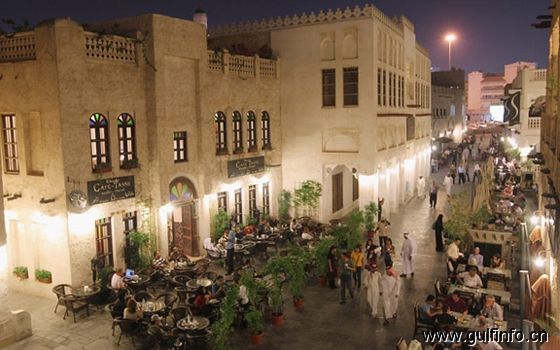随着赴卡商旅游客及海湾地区旅游者的增加,卡塔尔当局正计划构建一个更完善的悠闲娱乐产业。...

随着赴卡商旅游客及海湾地区旅游者的增加,卡塔尔当局正计划构建一个更完善的悠闲娱乐产业。
世界旅游观光委员会(WTTC)数据显示,卡塔尔2012年旅游观光行业对GDP的直接贡献达到34亿美元。但整个行业直接和间接(包括刺激其他相关行业发展)的贡献高达130亿美元,占到GDP的6.7%。WTTC预计2013年卡旅游业增长7.3%,2013至2023年间平均年增长率为4%,鉴于其对经济的深厚影响力,这些增长还有可能分别提高至8.1%和4.5%。
卡政府表示,赴卡游客年增长率有望达到20%,其中大部分来自海合会国家。旅游业发展与主体经济联系紧密,相辅相成。
卡塔尔工商会旅游委员会主席Saeed Al Hajri强调卡塔尔属于“高端豪华旅游地”,奉行“质量第一,数量第二”,将始终致力于顶级旅游市场,尤其鼓励周边富有的邻国国民前往,如沙特阿拉伯,当然,同时也欢迎全球其他富足的游客。Al Hajri还表示新一轮奢华酒店开业将进一步增加对海湾国家游客的吸引力。
另外,卡塔尔在明年年底将采用旅游卫星账户(TSA),这一举措有利于加强卡开发旅游业。TSA系统得到联合国的支持,该系统用于监控和评估旅游业对整个经济的影响,数据采集的加强和分析不仅有利于制定更好地政策,而且能够帮助调整产业结构,提高可持续发展和产业环境影响。
伴随战略规划和品牌发展的是大量资金投入。2011至2022年间,卡政府计划投资200亿美元开发旅游基础设施为世界杯做准备。这其中包括每年新建酒店房间5000个,从现在15000个房间增加到60000个,目的就是尽可能多地吸引顶级酒店品牌。
考虑到将来可能供大于求,卡塔尔旅游局将世界杯看做一个里程碑,并不是现在旅游业发展的终极目标。从长远来看,卡期望相关基础设施和世界杯能够帮助卡塔尔加强举办各类体育竞赛和其他活动的地位,保证今后稳定的游客量。会议、奖励旅游、大型企业会议和展览(MICE)是卡具有发展潜力的领域,卡在该领域已初具成就,2011年MICE游客占到其游客总数的72%。
卡塔尔并不打算建造成一个大众旅游地,而且考虑到其国土面积,现实条件也不允许。把精力放在商务、高端休闲、体育及短期中转游客方面显然是明智之举,这样更有利于旅游业对经济做出贡献,并促进经济多元化发展。
据悉,卡塔尔家居设计博览会(INDEX)将于2015年2月9日至11日在卡塔尔国家会议中心举办。家居家装展无疑是完成卡塔尔国家发展的重要一部分,展会是一个多元化产品博览会,由The Big5, INDEX, Workspace(前Office Exhibition)和The Hotel Show组委会DMG重磅打造,展会分为室内装潢、创新工作室、酒店装潢和装潢硬件设施四大板块。该展会势必成为卡塔尔家居装饰、酒店行业的一场交流盛会。
Qatar developing a broader leisure industry
With a strong existing market from business visitors, and a growing status among tourists from elsewhere in the Gulf, Qatar’s authorities are now focusing on developing a broader leisure industry.
The tourism and travel sector contributes QAR12.4bn ($3.4bn) to GDP directly, equivalent to 1.8% of economic activity, according to the World Tourism and Travel Council (WTTC). But the industry’s total contribution – direct, indirect and induced, including its boosting effect on other sectors – is almost four times as big, at QAR47.6bn ($13bn), or 6.7% of GDP. The WTTC expects sector growth of 7.1% this year, and an annual average of 4% from 2013 to 2023. For its broader impact on the economy, these figures rise to 8.1% and 4.5%, respectively.
On June 1, Saeed Al Hajri, chairman of the tourism committee of the Qatar Chamber of Commerce and Industry, announced that the state was stepping up its efforts to reach 20% annual growth in arrivals numbers, with a particular focus on visitors from other GCC member states. He said that tourism development goes hand-in-hand with broader economic growth, each supporting the other.
Al Hajri emphasized Qatar’s status as a “luxury destination” and a focus on “quality over quantity”, implying a continued concentration on the top end of the market – which particularly appeals to citizens of Qatar’s wealthy Gulf neighbors, including populous (and less liberal) Saudi Arabia, as well as well-heeled visitors from elsewhere in the world. Al Hajri said that new luxury hotel brands setting up in the country would further strengthen the appeal to visitors from the Gulf.
Qatar’s adoption of a Tourism Satellite Account (TSA) by the end of next year should further strengthen its ability to develop the sector. The TSA is an UN-approved system for monitoring and measuring tourism’s impact on the economy. Enhanced data collection and analysis should not only enable better policy planning, but also help structure development to improve sustainability and the industry’s environmental impact.
Along with strategic planning and brand development has come significant capital expenditure, with the state planning to invest $20bn in tourism infrastructure between 2011 and 2022 in preparation for the World Cup. This will include building an average of 5000 new hotel rooms a year, boosting the number from 15,000 to 60,000. The aim is to attract as many of the world’s top brands as possible.
Aware of the potential for oversupply, the Qatar Tourism Authority (QTA) sees the World Cup as a landmark, but not the only event towards which the sector should be geared. The expectation is that the infrastructure and profile boost associated with the World Cup will help enhance Qatar’s position as a host for sporting tournaments and events over the long term, ensuring a steady traffic of visitors. The meetings, incentives, conferences and exhibitions (MICE) segment is one potential target. This is an area where Qatar has already had some success, accounting for 72% of visitors in 2011.
As the new Hamad International Airport (formerly known as New Doha International Airport) ramps up to its 50m capacity, the QTA also expects the volume of transit passengers stopping over to increase. The first phase of the project is expected to be completed by the end of 2013, with the facility fully operational by 2020.
Qatar certainly does not intend to become a mass-market tourism destination; nor would this be realistic given its size. But by shrewdly focusing on segments such as business, luxury leisure, sport and short stays by transit travellers, it could increase the sector’s contribution to the economy, and support diversification.



